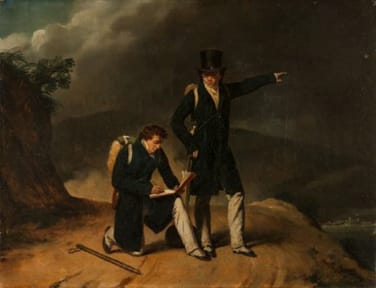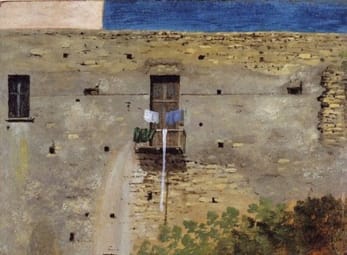
Prosper BARBOT
Study of Palm tree, 1826 c.
Oil on canvas
45,3 x 37,1 cm
Label on the back of the frame with the number: “88”
SOLD
Provenance
Caroline Garnon (1838-1900), née Barbot, daughter of the artist; Henriette Le Châtelier (1865-1934), née Garnon, daughter of the previous one; Georges Le Châtelier (1857-1935), husband of the previous one; Caroline Bour (1883-1947), née Leroux, granddaughter of the previous one; by descent to the previous owner.
Prosper BARBOT
(Nantes 1798 - Chambellay 1878)
The figure of the French architect and landscape painter Prosper Barbot formed part of that group of “explorers” who, in the first half of the 19th century, strayed from the rigid route of the 18th-century “Grand Tour”, most of the time capturing unseen aspects of the southern Italian landscape. After graduating from the Section d’Architecture of the École des Beaux-Arts, Barbot first undertook a trip to Italy from 1820 to 1822, in line with the École’s well-known policy of completing the architect’s training by means of study trips. In the course of this experience, Barbot created a corpus of six albums, assembled in the Voyage d’Architecture, now kept at the Département des Arts Graphiques of the Louvre in Paris, which contains drawings of numerous monuments and urban areas of the Italian peninsula.[1]
On his return home in July 1822, he definitively abandoned architecture to devote himself to landscape painting and painting en plein air and entered the studio of the painter Louis-Etienne Watelet, who was also a teacher of Théodore Caruelle d’Aligny.
He subsequently embarked on a new journey, first to Switzerland and then back to Italy in 1826 accompanied by his friend Jules Coignet, a firmly established landscape painter. This second trip to Italy was an opportunity for Barbot to rediscover with new eyes the places he had visited in the past as an architect (Fig. 1). In these new works, his way of telling the story of the places visited appears to have changed completely. Conceivably influenced by the then numerous en plein air artists and by having got to know a peer of his, the landscape painter Camille Corot.

Fig. 1 - P. Barbot, Les Promeneurs
Nantes, Museo delle Arti.
The artist’s notebooks allow us to identify his route with extreme precision: he returned to the places of his first trip and then moved south: the Amalfi Coast, Calabria, and Sicily. After a few months, the pair returned to Rome to spend the winter and most of the spring there.
We can say with good probability that it was at this point that Barbot painted our palm tree, probably the “only” or rather one of the “only” palm trees in Rome, of which the museum of Angers kept a copy that would be destroyed during World War II.[2]
Palm trees were in fact relatively rare in Rome at the beginning of the 19th century; most grew in cloisters, such as those in the Churches of San Bonaventura al Palatino, San Francesco a Ripa, San Pietro in Vincoli or even San Giovanni e Paolo, “the beautiful palm of which Rome boasts” to use the words of Madame de Staël in her novel Corinne, ou l’Italie (1807). The Villa Malta also had a famous palm tree given by Goethe to a friend of his.
In this picture the artist elaborated a particular palette of refined tones, deep shades of various browns. Here, even more than anywhere else, the influence of Corot’s painting can be sensed.
It should also be noted that the photographic cut of its framing makes the painting incredibly contemporary, almost minimal, bringing it closer to the iconic works of Thomas Jones (Fig. 2). The blemished plaster of the narrow portion of the building at the bottom, the flaking tiles, make the work unconventional, anti-monumental.
It is interesting to note that, just like Thomas Jones in Naples, who portrayed not the usual “views” of Vesuvius and the gulf but the city of walls and stones, in Rome Barbot did not depict a glimpse of the Colosseum or a view with complex architectural structures of an ancient or Renaissance Rome, but a palm tree, a detail that attracted his attention due its strongly exotic flavour.
After three years in Italy, Barbot left Rome for good on August 8, 1828. On August 26, we find him in Paris again where he set up a studio. He was to exhibit regularly at the Salon in the following years until 1840, a date which marked his departure from the art scene.

Fig. 2 - Thomas Jones (1742- 1803), Muro a Napoli, 1782
Join the mailing list
Subscribe to our newsletter to receive all the news about exhibitions, fairs and new acquisitions!